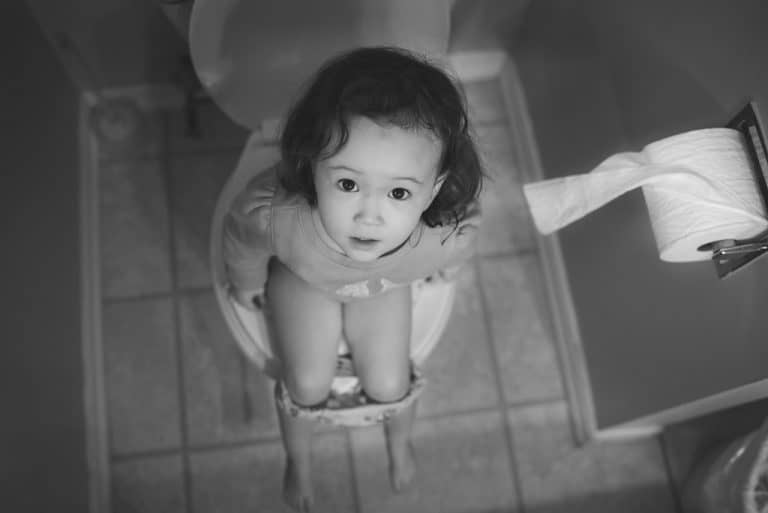Disclaimer: I am positing my own theories here about the connection between childhood potty training and adult pelvic health. I do not want to be alarmist and make you think you’ve scarred your child for life. I do not have research to suggest anything of the sort, but I want to invite you to think critically about these connections. Push back, disagree with me if you want – I’d love to discuss.
Pause for a second and ask yourself what humans did before disposable diapers. Ok, cloth diapers. But what about before that? And before washing machines? Most likely, we’ve been covering babies’ behinds with something for millennia, but lacking a washing machine, we definitely wouldn’t have had kids in diapers until 3 and 4 years old. It would have been unsafe and unsanitary prior to running water.
So, parents took a much more active role in teaching kids where to do their business from a much younger age. At its core, that’s what EC is. EC is elimination communication and it’s just the idea of reducing reliance on diapers as early as birth. You can learn everything you could ever want to know about EC here.
We do EC part time and we love it. Babies are so much more capable than you think. At just a couple months old, a baby will wait to be offered an alternative receptacle rather than go to the bathroom in their diaper. At 18 months, children are fully capable of being potty trained. In fact, in 1957, 92% of children were potty-trained by 18 months. And it makes sense. If you really think about it, the idea of diapers is pretty disgusting.
I want to be clear, though, I’m not judging you. It’s not your fault if you don’t do EC. The diaper companies have a vested interest in getting us to teach our kids to pee and poop themselves – and to keep doing it for as long as possible. Reducing diaper reliance by a year or two would lose the diaper companies BILLIONS in profits. You can learn more about this here.
So, what does this have to do with pelvic health and this site? Last Friday my daughter came home with the worst diaper rash she’s ever had. We’re working with the daycare to make sure she’s being changed more often. But, in the moment, I was PISSED. I know her rhythms and signals and I know that she was probably spending 2 and 3 hours sitting in her own excrement. And my baby was in pain. I got real Mama Bear mad.
She was in so much pain, it seemed like she was resisting going to the bathroom. She seemed afraid. I couldn’t help but wonder – is this pain negatively impacting her pelvic health? Could she get a UTI from refusing to go potty? What happens when kids are experiencing this kind of pain for 3, 4, and 5 years?
So, pain. I talk about pain a fair amount in my workshops, but I’ll quickly summarize here. Pain causes our muscles to engage and shorten. We draw back and often physically close in. Pain also causes our body to move into a sympathetic nervous system state, or fight or flight. In this state our senses are heightened – great if you’re going to fight a tiger, not great if you need to go to the bathroom. Pain also creates more pain. The more we constrict and tighten, the less we can move without additional pain (this is a little complicated, but stay with me).
So, if a little girl were having chronic diaper rash, UTIs, or any other pelvic pain, why kind of dysfunction might that create?
Delayed toilet training may also introduce fear. According to the Montessori method, the optimal age for potty training is 18 months. We’ve been fed the diaper companies’ “research” about readiness, but I can tell you, having recently gotten our daughter to sleep through the night, she was not going to reach “readiness” on her own.
Our job as parents is to give our kids the structure and support to create healthy habits for life. If we allow a toddler (who has never experienced the toilet) to decide if they’re ready to potty train, the answer will always be no. Nobody wants to do something scary, new and unfamiliar.
If we hold off for too long and create fear and resistance around toilet training, what might that do to our daughters’ pelvic health?
So, obviously, I’ve talked a lot about our kids. But if you’ve been a little girl in diapers, this applies to you, too. In my workshops I always talk about the fact none of was ever a blank slate. It’s easy to be reductionist and say that “Well, this pregnancy or that injury created a movement pattern that ultimately created chronic pelvic pain.” However, before that pregnancy or injury, you lived an entire life. Even in utero, babies can create a head-turning or ankle crossing preference. No one thing is responsible for everything about us.
Potty training is one of our earliest experiences of taking ownership of our bodies, and specifically, our genitals. Fear and pain can have profound and lasting ripple effects throughout the rest of our lives. I encourage you to reflect on how your early pottying experiences may have started shaping your own pelvic health, and ask yourself how you’re influencing the pelvic health of your kids.

